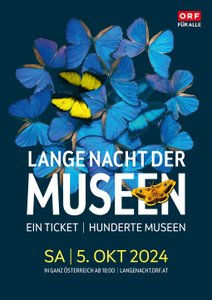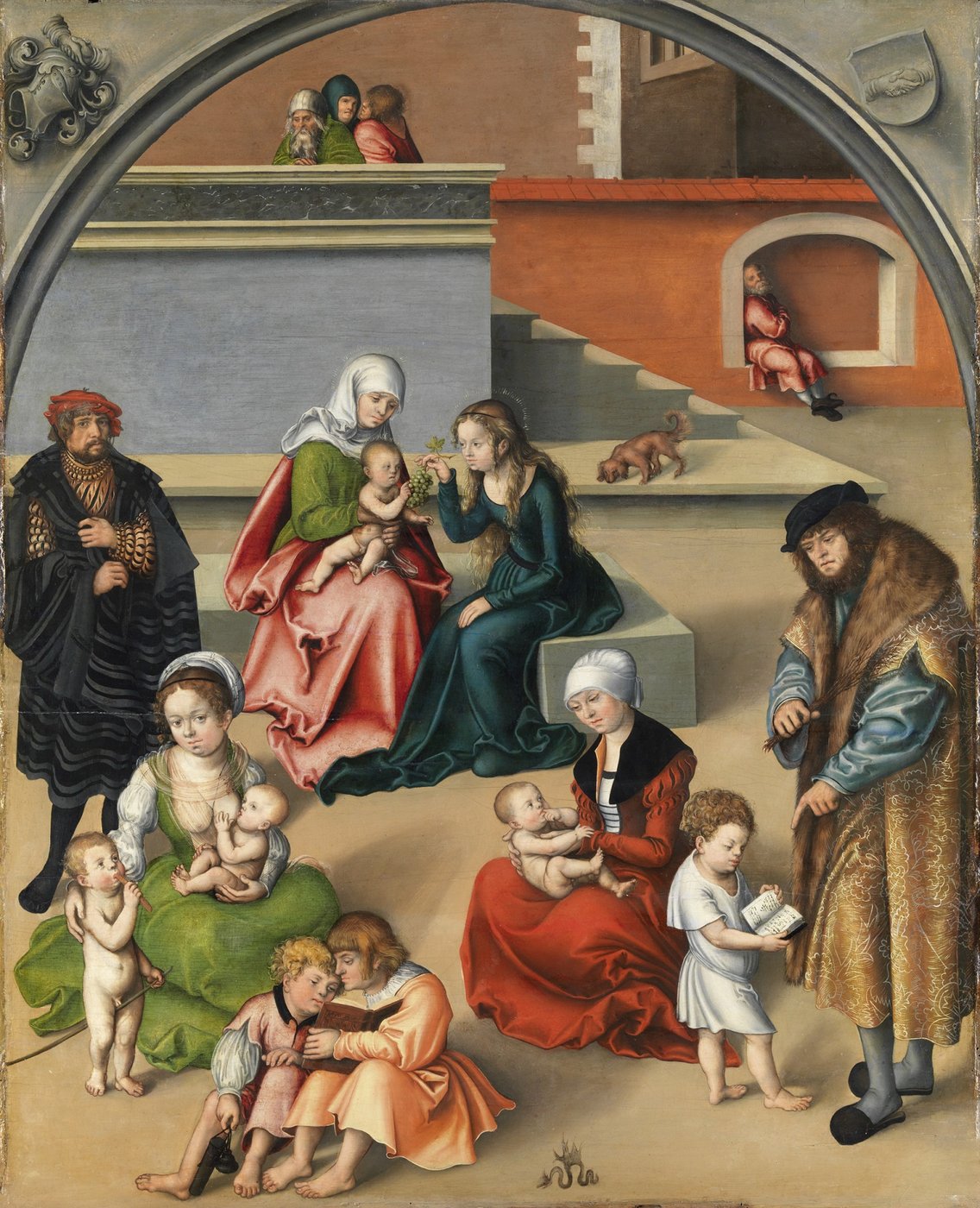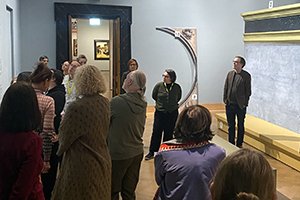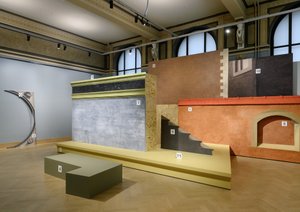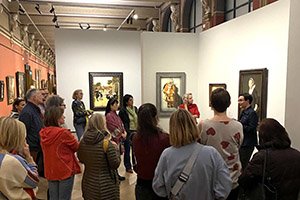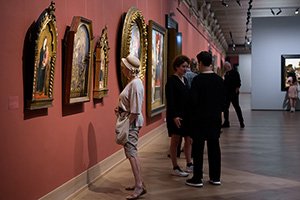Considering the Collection & Cranach’s Holy Productivity An Insert by Klaus Scherübel
Considering the Collection & An Insert by … is a recently established temporary exhibition format presenting highlights from the Paintings Gallery collection, from Bosch to Rubens, as well as works with links to the Insert, an artistic intervention created by a contemporary artist as a critical statement on the Academy’s historical art collections. The second Insert in the series features Montreal-based Austrian artist Klaus Scherübel.
Considering the Collection
The exhibition concentrates on the Baroque period, presenting a cross-section of the core of the collection, the bequest of Anton Paula Graf Lamberg-Sprinzenstein from 1822. Other points of focus are the development of representations of space in early modern painting north and south of the Alps, the work of the Renaissance artist Lucas Cranach the Elder, portraits and self-portraits of artists in the eighteenth and early nineteenth centuries, and the use of architectural fragments in Baroque painting. These topics refer to Scherübel’s insert, Cranach’s Holy Productivity VOL. 28.
Works by Hans Baldung Grien, Hendrik van Balen, Herri met de Bles, Hieronymus Bosch, Alessandro di Mariano Filipepi, known as Botticelli, Sébastien Bourdon, Dieric Bouts, Adriaen Brouwer, Joos van Cleve, Pieter Codde, Lucas Cranach the Elder, Anthonis van Dyck, Antonio da Fabriano, Barent Fabritius, Francesco Raibolini, known as Francia, Heinrich Friedrich Füger, Jan Fyt, Luca Giordano, Pieter de Hooch, Ambrosius Holbein, Jacob Jordaens, Bernardo Keilhau, known as Monsù Bernardo, Johann Baptist von Lampi the Younger, Nicolaes Maes, Hans Maler, Nicola Malinconico, Martin van Meytens, Bartolomé Esteban Murillo, Rembrandt van Rijn, Peter Paul Rubens, Jacob van Ruisdael, Isaack van Ruisdael, Jacob van Schuppen, Christian Seybold, Pierre Subleyras, Jan Cornelisz. Vermeyen, Domenico Maria Viani, David Vinckboons, Cornelis de Vos, Ferdinand Georg Waldmüller, Jan Wildens et al.
Curated by Claudia Koch
Cranach’s Holy Productivity VOL. 28
An Insert by Klaus Scherübel
Against the backdrop of his installations that engage with the museographical genre of the period room, and related conceptual works in which aspects of painting, the book, sculpture, architecture and exhibition design enter into relation with one another, Klaus Scherübel’s current project deals with modes of depicting space and architecture in connection with questions of artists’ self-portrayals and strategies of productivity, using the example of a work by Lucas Cranach the Elder, one of the most important painters of the German Renaissance and Reformation.
The work in question is The Holy Kinship (1510–1512) from the collection of the Paintings Gallery, thought to have been created by Cranach on the occasion of his marriage to Barbara Brengbier, the daughter of a patrician family. Due to its strongly portrait-like character, this painting is among the special forms of a motif that was common until the seventeenth century: Cranach portrays himself, his wife and his father-in-law in the roles of members of the Holy Kinship. Apart from this unorthodox interweaving of the two family portraits, in which religious themes overlap with real social relations and interests, Scherübel focusses above all in the architectural setting within which the Holy Kinship is placed. Among others, this raises the question of whether and how this setting can be linked to the specific context within which the painting was made, and to the commercial aspect of Cranach’s art production.
Scherübel’s intervention consists of a spectacular translation of the painting’s architectural setting into a three-dimensional stage. Further works made specially for the exhibition are on display in a separate room.
Curated by Sabine Folie
Klaus Scherübel (*1968 in Bruck/Mur, lives in Montreal) worked as fashion designer in the late 1980s and studied at the University of Applied Arts in Vienna, with Vivienne Westwood among others. Starting from a critical stance towards the fashion system, Scherübel developed a Conceptual art and Institutional critique oriented practice, operating at the intersections of art and affiliated disciplinary fields such as literature, theater, film, architecture, etc. Within his work, Scherübel adopts various roles – as an artist at work, an editor, a curator, a sponsor – to engage in a performative way with the conditions and the history of the artistic production, presentation, and reception. His œuvre encompasses expansive installations, including a dialogical relationship with photography, printmaking, painting, time-based media and text. The book plays a central role both as object and concept, hereof a relevant book has to be mentioned, Klaus Scherübel edited – Mallarmé, Das Buch, Cologne 2001. The book has been published in several languages and has become a reference in the field of artist books. He published a survey on this work in 2011 entitled Klaus Scherübel VOL. 13. Since 2013, he has been creating architectural sculptures dedicated to the preservation and expansion of Martin Kippenberger's METRO-Net project.
His work has been exhibited internationally, including the Leopold-Hoesch-Museum, Düren (2023); VOX, centre de l’Image contemporaine, Montreal (2019, 2016); Künstlerhaus, Halle für Kunst & Medien, Graz (2016); mumok, Vienna (2015, 2012); Centro Universitário Maria Antonia USP, São Paulo (2014); S.M.A.K., Ghent (2009); MoMA PS1, New York (2009); Generali Foundation, Vienna (2008).
List of entries
-
-
Representation & Self-Questioning – The Artist's Image and Self-Portrait in the 18th and 19th Centuries
Guided Tour
Schillerplatz
Paintings Gallery
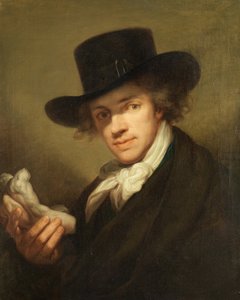
-
-
-
Sabeth Buchmann: In the shadow of the pictures
Lecture series Lektionen / Lessons
Schillerplatz/ Conference room
Paintings Gallery
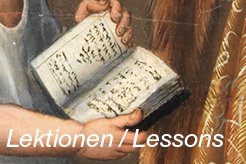
-
-
-
-
Gunnar Heydenreich: The Cranach Digital Archive. Gaining knowledge through international and interdisciplinary research cooperation
Lecture series Lektionen / Lessons
Anatomy Hall, Schillerplatz 3, 1010 Vienna
Paintings Gallery

-
-
-
-
-
-
-
-
Tom Holert: How anachronistic is that? Klaus Scherübel and the history of the "period rooms"
Lecture series Lektionen / Lessons
Schillerplatz/ Conference room
Paintings Gallery

-
-
Guido Messling: The artist is present. Where and why Cranach put himself in the picture
Lecture series Lektionen / Lessons
Schillerplatz 3, 1010 Wien, Anatomy hall
Paintings Gallery

-
-
Vienna Art Week 2024: Curator’s tour
Guided tour with Sabine Folie and Claudia Koch through the exhibition Considering the Collection & Cranach’s Holy Productivity An Insert by Klaus Scherübel
Schillerplatz
Paintings Gallery
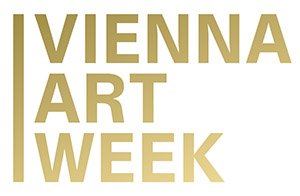
-
-
-
-
-
Insa Christiane Hennen: Lucas Cranach’s Holy Kinships. Images of God in complicated relationships
Lecture series Lektionen / Lessons
Schillerplatz/ Conference room
Paintings Gallery

-
-
Sandra Hindriks: Exemplary productivity. On the topicality of depictions of the Holy Kinship around 1500
Lecture series Lektionen / Lessons
Schillerplatz/ Conference room
Paintings Gallery

-
-
ORF Lange Nacht der Museen 2024
Guided tours of the exhibition on the hour from 18 pm to 23 pm.
The Paintings Gallery is open until midnight 12 pm.
Schillerplatz
Paintings Gallery
